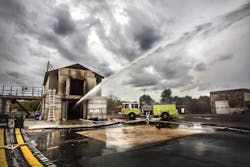Research Corner: How Much Air Does a Hose Stream Entrain?
As the fire service has evolved, so have our tools to deliver the primary extinguishing agent, water, to the seat of the fire. What was once delivered with a smooth-bore nozzle can now be applied in various spray patterns through numerous types of adjustable pattern spray nozzles.
All types of nozzles available today have their pros and cons. Although efforts have been made to develop the “Swiss Army knife” version of the nozzle, no one nozzle works best in every situation. Understanding how each nozzle functions and how to best operate it based on the situation is imperative to selecting the right tool for the job.
Study outline
Quantifying how nozzles deliver water is a portion of UL’s Firefighter Safety Research Institute’s (FSRI) 2013 DHS AFG Research and Development grant titled “Study of the Impact of Fire Attack Utilizing Interior and Exterior Streams on Firefighter Safety and Occupant Survival.” The three-year study, awarded in September 2015, involves four phases of testing.
- UL FSRI’s firefighter researchers looked to expand on the work done by Knapp et. al1 at Rockland County’s training facility on how much air is entrained with a nozzle when used for hydraulic ventilation.
- We conducted water-mapping experiments, looking at how various nozzles apply water within a compartment.
- We will conduct 25 full-scale fire experiments in a ranch-style structure to examine interior and exterior water application techniques to quantify how each technique effects fire suppression.
- A series of field experiments will bring the previous three pieces together and expand on what we learn.
The full research report is scheduled to be completed in 2017.
Air entrainment
Air entrainment is the fluid dynamics phenomenon where an object moves through a fluid, it displaces some of the fluid, creating a drag force. This occurs with all water streams used in fire suppression. As a water stream travels through air, the drag force will pull air along its path. The factors that influence this are: 1) the velocity/speed at which the water is moving, 2) the stream pattern (straight stream, semi-fog, etc.), 3) the size of the water droplets and 4) the volume of water being flowed. As the air is entrained, it will be pulled to wherever the water is traveling. Air entrainment causes pressure differentials, which create flow. The flow from the air entrainment will be influenced and sometimes opposed by the pressure created by the fire. These changes in pressure will influence the hot gas layer and even the flow path in a structure.
Understanding how much air a particular water stream entrains will help firefighters understand how to better utilize the hose stream for their intended purpose.
Methodology
UL FSRI used the same principal as Knapp et al., that as air leaves a structure, it creates a lower pressure inside than outside. This pressure differential causes a flow from the outside to the inside. This flow can be measured without interruption by the water stream and is representative of the flow being directed out the opening by the air entrainment of the hose stream.
The nozzle was setup inside the structure, flowing out a fixed opening size (double doors). The nozzle was placed such that the trajectory of the water was not affected by gravity before it left the structure (18 feet from the doors). Double doors on the level above were left open. The stairwell door was instrumented to measure how much flow was being drawn in (Figure 1). Table 1 below shows the different types of 1½-inch nozzles (connected to 1¾-inch hoselines), flows and pressures tested. Nozzles sold by three major nozzle manufacturers were utilized for the test. Flow was measured with a bi-directional probe array, where five bi-directional probes were placed vertically in the opening.
Results
A comparison of the three nozzle manufacturers for each nozzle showed almost no variation between manufacturers, indicating that the air entrainment is more dependent on the pattern than the manufacturer.
Figure 2 above shows the results from a single manufacturer, comparing a smooth-bore nozzle flowing 150 gpm at 50 psi and an adjustable pattern nozzle also flowing 150 gpm at 50 psi. When the nozzles were held steady, they both entrained air. The smooth bore entrained less air, but relatively the same magnitude. When the same nozzles were used with a pattern such as an “O,” “Z” or “N,” the air entrainment increased by a factor of over five times. The type of pattern chosen made minimal difference.
In sum
Understanding air entrainment helps firefighters choose the correct nozzle pattern/technique. In instances where a crew is attempting to affect the flow of hot gasses, using a nozzle technique that entrains air would be desired. In an instance where crews are attempting to avoid disrupting the thermal environment, a different nozzle pattern/technique is required. Firefighters with an understanding of air entrainment can use this knowledge to their advantage during fire attack.
Using a pattern is only one piece of the puzzle when it comes to understanding how different hose streams entrain air. Our next article will expand on this concept, looking at how flow rate, pressures and the distance the stream travels before hitting a surface affect the amount of air entrained.
References
1: Knapp, J, Pillsworth, T, White, SP. “Nozzle Tests Prove Fireground Realities.” Fire Engineering. February 2003. 71–80.
About the Author

Robin Zevotek
Robin Zevotek is a Principal Fire Protection Engineer with the Technical Services department at the National Fire Protection Association (NFPA) where he provides technical expertise in emergency response and responder safety as well as fire protection and building life safety. He holds both bachelor’s and master’s degrees in Fire Protection Engineering from the University of Maryland. With over 20 years experience in fire and emergency services, and extensive work in fire engineering and research, he provides a unique blend of technical knowledge and practical experience. In addition to his work at NFPA, he continues to gain practical experience and apply his expertise as the fire chief with the Ellicott City Volunteer Fire Department in Howard County, MD.
